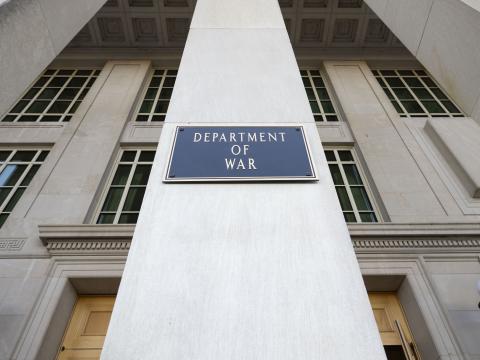Joint Information Environment Is Under Way
The military’s plan to create a single, secure information-sharing environment for all the services finally is taking shape. After much talk and planning, the U.S. Defense Department’s Joint Information Environment (JIE) now is being built with its first component reaching initial operational capability this summer.
“The JIE is not coming, it is here,” said Lt. Gen. Mark S. Bowman, USA, director, command, control, communications and computers (C4)/cyber, and chief information officer (CIO) for the Joint Staff and J-6/CIO. Details of the JIE’s launch and what it will mean for the military, as described by Gen. Bowman and other top Defense Department officials, were the main focus of the AFCEA International Northern Virginia Chapter’s 6th Annual Joint Warfighter IT Day, “Leveraging Technology to Achieve Force Dominance Across the Services,” held in McLean, Virginia, on September 12.
The European part of the JIE, known as Increment One, reached its initial operating capability on July 1, Gen. Bowman said. Work is ongoing to further broaden Increment One capabilities and systems for the U.S. European Command. The three areas where work is under way are network consolidation, enterprise capabilities and applications, and enhancing cyber operations security, he said.
Two other JIE increments are next. They will cover the U.S. Pacific Command and operations in the continental United States. Although work now is under way and a schedule is in place, it is only a draft schedule and is subject to change, explained Robert J. Carey, principal deputy CIO, Defense Department. The march to setting an overall baseline for the JIE will follow a set of linked events across the Defense Department enterprise that will progress as funds and time allow. Citing the tentativeness of the schedule, Carey would not provide further details about the next two increments, but he noted that the effort’s progress and activity will ramp up significantly in 2014.
The JIE will connect all of the services together. For the U.S. Air Force, this means that it will serve as the basis of the Air Force’s future interoperability needs, explained Lt. Gen. Michael J. Basla, USAF, the service’s chief information dominance officer and CIO. To meet the Defense Department’s guidelines to move to the JIE, the Air Force is centralizing its information technology authority as well as working on guidelines to bring the service’s individual networks into a larger architecture. As the Air Force eliminates redundant networks, it can focus on providing information technology services more efficiently. “This will be the foundation of the future of joint warfighting,” he said.
Once the transition to the JIE is complete, it will improve commanders’ and warfighters’ command and control capabilities, said Adm. James Winnefeld, USN, vice chairman of the Joint Chiefs of Staff. When the environment is fully up and running, it will allow forces to seamlessly transition their data and orders from garrison to deployment missions and back again.
The JIE also will allow warfighters to work jointly and collaboratively in a secure information sharing environment. Its architecture permits the seamless use of shared battlefield tools such as joint fires and maneuver applications. “JIE is not just a set of lofty expectations—we’re making it operational today,” Adm. Winnefeld said.
A key benefit of the JIE will be the ability to connect military networks out to the very tactical edge, something the Defense Department currently cannot do, Carey said. Another issue is that the current military computing environment is broken up into service-oriented silos, which allow software based capabilities and tools to be deployed in a single domain but not across the entire Defense Department enterprise.
The JIE will feature an integrated cyber defense system with a single security architecture (SSA) at its core. The SSA already is being built out as part of the JIE rollout in Europe, said Lt. Gen. Ronnie D. Hawkins Jr., USAF, director of the Defense Information Systems Agency (DISA). DISA is working with the services to get the security architecture into place.
DISA also is helping the services merge their networks into a single architecture, as opposed to the many individual networks that currently exist at the base, camp and post level, Gen. Hawkins said. By building out the SSA, he believes that this consolidation process can be accelerated with the knowledge that data security will be built in from the start, he said.
Another part of the department’s overall plan is for the Global Information Grid (GIG) to evolve into the JIE. As it stands, the GIG is a heterogeneous mix of networks and domains that is hard to defend and expensive to operate, Carey explained. In contrast, he described the JIE as a design concept with a single set of standards and architecture that will be rolled out across classified and unclassified networks.
Setting up the JIE will also be a change in the way the Defense Department does business. There will be no large, monolithic contracts, no big pot of money to win, Carey said. Exactly how the JIE is implemented will be up to the department and the services’ budget prioritization plans. He added that despite some criticism, the initial slow pace of getting the JIE process established reflected the realities of handling such a complex undertaking.
The significant difference between the JIE and other major information technology efforts in the Defense Department is that the JIE is not a program of record—not a formal program in the traditional defense sense, with offices and management infrastructure. “We don’t want one,” Gen. Bowman said. Instead, the JIE is run as a lean effort, with only three top leaders/administrators—Carey included. The JIE is using existing programs and technologies to develop its architecture. But, he cautioned industry that the JIE is not a platform to hook a program onto simply to get funding.




Comments